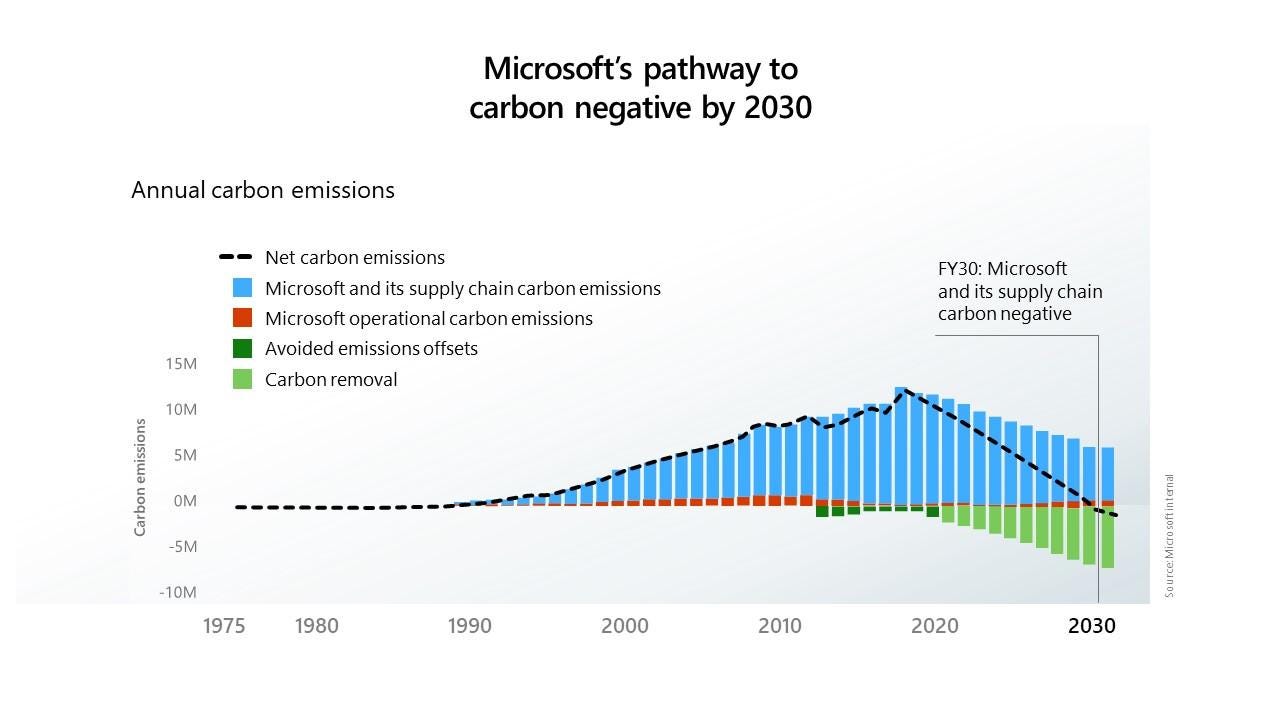Microsoft's ambitious plan to remove its entire carbon footprint

Microsoft has announced its plan to be carbon negative by 2030, and the company hopes that by 2050, it will have removed from the environment all the carbon that has been emitted by its business -- directly and by electrical consumption -- since it was founded in 1975.
"The world's climate experts agree that the world must take urgent action to bring down emissions," Microsoft said in a blog post.
"Ultimately, we must reach 'net zero' emissions, meaning that humanity must remove as much carbon as it emits each year. This will take aggressive approaches, new technology that doesn't exist today, and innovative public policy."
See also: These 10 technologies are most likely to help save planet Earth
The blog, penned by Microsoft president Brad Smith, labels the plan as "ambitious" and even "audacious", but ultimately being a backer of science. The company realises being carbon neutral isn't enough.
"Science tells us that it's a goal of fundamental importance to every person alive today and for every generation to follow," it says.
"If we don't curb emissions, and temperatures continue to climb, science tells us that the results will be catastrophic."
Its plan will see Microsoft take responsibility for its carbon footprint by being a voice for lowing emissions, being "grounded in science and math", investing in carbon reduction and removal technology, and providing transparency.
"It's vital that our work as a company to address carbon issues stay grounded in ongoing scientific advances and an accurate reliance on the basic but fundamental mathematical concepts involved," the blog explains.
"While we at Microsoft have worked hard to be 'carbon neutral' since 2012, our recent work has led us to conclude that this is an area where we're far better served by humility than pride. And we believe this is true not only for ourselves, but for every business and organisation on the planet."

Microsoft expects to emit 16 million metric tons of carbon this year.
See also: Carbon dioxide levels reach highest recorded levels in human history (CNET)
Of this total, about 100,000 are scope one emissions -- direct emissions that activities create, such as a car exhaust; about 4 million are scope two emissions -- indirect emissions that come from the production of the electricity or heat used; and the remaining 12 million tons all fall into scope three -- the indirect emissions that come from all the other activities, including the emissions associated with producing food eaten or manufacturing the products purchased.
"We've identified another shortcoming that we and many other companies need to overcome. Historically we've focused on Microsoft's scope one and two emissions, but other than employee travel, we haven't calculated as thoroughly our scope three emissions," it said. "That's why we're committing to becoming carbon negative for 2030 for all three scopes."
By 2025, Microsoft said it will shift to 100% supply of renewable energy, which means it will have in place power purchase agreements for green energy contracted for 100% of carbon-emitting electricity consumed by all of its data centres, buildings, and campuses.
It will also electrify its global campus operations vehicle fleet by 2030.
While that covers scope one and two emissions, to reduce scope three emissions by over 50% by 2030, Microsoft will also in July start phasing in its current internal carbon tax to cover scope three emissions.
Currently, this fee is $15/metric ton and covers all scope one and two emissions, plus scope three travel emissions.
Starting in July, all its business divisions will also pay an internal carbon fee for all their scope three emissions.
See also: The Internet of Wild Things: Technology and the battle against biodiversity loss and climate change (TechRepublic cover story) | Download the free PDF version (TechRepublic)
"By 2030, Microsoft will remove more carbon than it emits, setting us on a path to remove by 2050 all the carbon the company has emitted either directly or by electrical consumption since it was founded in 1975," the blog continues.
"We will achieve this through a portfolio of negative emission technologies (NET) potentially including afforestation and reforestation, soil carbon sequestration, bioenergy with carbon capture and storage (BECCs), and direct air capture (DAC)."
The company's plan will be funded by this fee.
$1 billion over four years has also been earmarked for a new Climate Innovation Fund that Microsoft will use to "stimulate and accelerate the development of carbon removal technology".
The company will mostly spend the capital on accelerating ongoing technology development by investing in project and debt finance, and by investing in new innovations through equity and debt capital, it said.
Additionally, Microsoft said it would continue to invest in carbon monitoring and modelling projects through its AI for Earth program.
The company is also launching an initiative to use its tech to help suppliers and customers reduce their own carbon footprints. In early 2021, Microsoft will also make carbon reduction an explicit aspect of its supply chain procurement processes.
Further details, it said, be published in a new annual Environmental Sustainability Report.
RELATED COVERAGE
- Does AI have the solution to climate change and human trafficking?
- Microsoft commits $50 million to apply AI to the problem of global climate change (TechRepublic)
- Amazon allegedly threatened to fire employees for speaking out on climate change (CNET)
- Data breaches, cyberattacks are top global risks alongside natural disasters and climate change